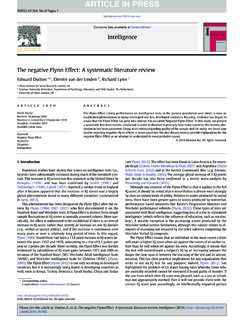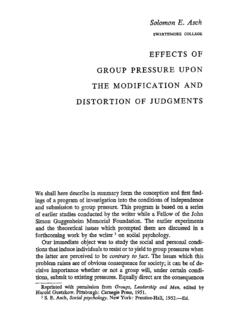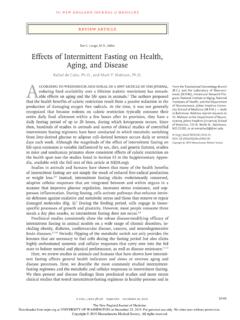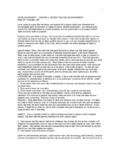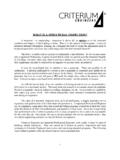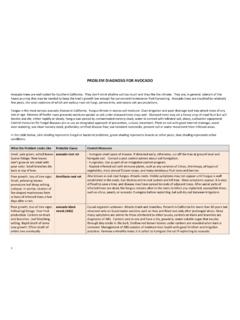Transcription of IQ decline and Piaget Does the rot start at the top?
1 Contents lists available atScienceDirectIntelligencejournal decline and Piaget : does the rot start at the top?James R. Flynn , Michael ShayerUniversity of Otago, New ZealandABSTRACTThe IQ gains of the 20th century have faltered. Losses in Nordic nations after 1995 average at IQ pointswhen projected over thirty years. On Piagetian tests, Britain shows decimation among high scorers on three testsand overall losses on one. The US sustained its historic gain ( points per year) through 2014. The Netherlandsshows no change in preschoolers, mild losses at high school, and possible gains by adults. Australia and Franceoffer weak evidence of losses at school and by adults respectively. German speakers show verbal gains andspatial losses among adults.
2 South Korea, a latecomer to industrialization, is gaining at twice the historic US a later cohort is compared to an earlier cohort, IQ trends vary dramatically by age. Piagetian trendsindicate that a decimation of top scores may be accompanied by gains in cognitive ability below the also reveal the existence of factors that have an atypical impact at high levels of cognitive data from conventional tests confirm the decimation of top scorers but not factors of atypicalimpact. Piagetian tests may be more sensitive to detecting this IntroductionScandinavian data suggest that there has been an IQ decline in someadvanced nations and that it began about 1995. The US is of interestbecause it appears to the leading exception to IQ decline .
3 Great Britainmay be more important because it allows us to compare trends onRaven's Progressive Matrices with those on Piagetian tests. We willcompare trends in all of these nations to trends in advanced comparative analysis does not included developing nationsbecause: either the samples are local and the trends best explained byfactors peculiar to the recent history of the locale (Brazil); or thesamples are atypical (Saudi Arabia).For completeness's sake,Colom, Flores-Mendoza, and Abad (2007)compared children aged 7 to 11 who took the Draw-a-Man test in thecity of Belo Horizonte, Brazil: 499 in 1930 and 710 in 2002. Over the72 years, they gained 17 IQ points for a rate of points per , Costa, and Arteche (2012)compared children aged 6 to 12from the state schools of Porto Alegre.
4 They compared 294 assessedduring 1980 decade with 203 assessed during the 2000 decade onDraw-a-Man and found no gain. They also compared 562 children as-sessed during the 1990 decade and 243 assessed during the 2000decade on Raven's Coloured Matrices and found the same. The authorsbelieve that the most likely cause of the trend is that the management ofprimary state schools is now the responsibility of local councils, ratherthan of the state education department. As a result, primary schoolssuffered a decline in their budget and perhaps worse overall quality ofprimary education. In Saudi Arabia,Bakhiet, Baraket, and Lynn (2014)found substantial gains by schoolchildren from 1999 to 2013 on theColoured Matrices that matched those ofColom et al.
5 (2007)from 1977to 2010 on the Standard Progressive Matrices. But Bakhiet's sampleswere boys who were our analysis, we will suggest two tentative hypotheses. First,trends on conventional tests show those at most risk of IQ decline arehigh school students aged 14 to 18. However, Piagetian results inBritain imply losses at earlier ages. Second, Piagetian tests signalsomething extra: conflicting trends between top scorers (those at thehighest or formal level of cognitive development) and those in the earlystages of the next level (concrete generalization). Large losses at theformal level may be accompanied by gains at the concrete level. We willargue that conventional IQ tests can show this phenomenon but are lesslikely to do Approach to assigning causesOur approach will be essentially sociological, that is, matching IQtrends with changes in the cognitive demands of social institutions likethe family, the schools and the world of work.
6 Over several generations,there is no doubt that dysgenic selection lowered the quality of genesfor intelligence and increased migration had an adverse effect. Konget al. (2017)found that genes predictive of educational attainment andghave been declining steadily across birth cohorts in 22 September 2017; Received in revised form 20 November 2017; Accepted 27 November 2017 Corresponding Shayer).Intelligence xxx (xxxx) xxx xxx0160-2896/ Crown Copyright 2017 Published by Elsevier Inc. All rights cite this article as: Flynn, , Intelligence (2017), Menie, Pe aherrera, Fernandes, and Figueredo (2017)did a syntheticliterature search that yielded a total of 66 observations of secular IQdecline from 13 countries with a combined sample size of 302,234,which spanned the 87 years from to They found thathigh levels of immigration were correlated with IQ decline , particularlywhen the decline was measured by tests with a high g , our analysis focuses on a relatively brief period fromabout 1980 to 2014, or about one generation.
7 Clearly during most ofthe 20th century social factors were so potent that they overwhelmedother negative trends, hence IQ gains over is every reason to believe that the same thing occurs in thetransitional generation we analyze, except that the social factors maynow have turned from positive to negative. It is true that at the end wespeak of prospects over the 21st century in sociological terms but onlybecause social factors look predictable while dysgenic selection con-cerning the future is harder to anticipate and The Scandinavia dataDutton and Lynn (2013)conclude that immigration in Scandinaviaduring this period is too small to be an important 1tracestrends on military tests of 18 19 year olds in Finland, Denmark,Norway, and Sweden (Dutton & Lynn, 2013; R nnlund, Carlstedt,Blomstedt, Lars-G ran Nilsson, & Lars Weinehall, 2013; Sundet,Barlaug, & Torjussen, 2004; Teasdale & Owen, 2008).
8 Between nations,the results are remarkably uniform. The averages by nation in boldmake this year in which gains turn into losses cluster around 1995. Thelast rates of gain average at IQ points per year over the previousdecade (with Norway the period is 16 years). We have includedSweden, which has no recent data but which shows signs of lapsing intolosses in 1993. The rates of loss are almost identical, just above orbelow - total losses over the time the data cover look small. But whenprojected over a generation (30 years), Finland would lose pointsof overall IQ, Denmark points, and Norway points for anaverage of points. Nonetheless, it would be useful to see if father-son comparisons differ from the results as 1also reportsresults from the Swedish Technical Comprehension Test.
9 We omitted itfrom our calculations because its content is atypical of most IQ tests. Itposes specialized technical and physical Recent trends the United StatesAmerica appears to show a steady rate of gain from 1989 to 1995 to2002 to 2007 to 2014 on Wechsler tests, which is just about its historicrate of IQ points per year. The estimates are often based on smallsamples that took both an earlier and later edition of a Wechsler test incounterbalanced order. They scored higher against the older norms thus signaling that the performance of the standardization samples hadimproved over method poses the problem of allowing for changed contentbetween tests. Eventually, the Wechsler architects did what needed tobe , Gregoire, and Zhu (2016)compared the standardiza-tion sample performance on the WISC-IV (normed in ) with anappropriate sample also tested on the WISC-IV some years later( ).
10 They selected 126 subjects, representative of the WISC-Vsample and called the new sample. To get 126 controls from theearlier WISC-IV standardization sample, they selected 100 samples ofmatched subjects, calculated the Full Scale IQ of each and took themedian score of these as the IQ of the old sample. When the newsample took the WISC-IV, their scores showed a gain of points peryear. This both adds reliability to other estimates and shows that the USdid not suffer losses up to 2014. There are also a number of comparisonsbetween different forms of the Wechsler, between the Wechsler and theStanford-Binet, and between the SB-4 and SB-5, which confirm theseTable 1 Mental test trends in Scandinavia divided into recent gains and losses (measured in IQ points)


